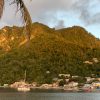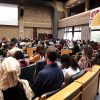Saturday, May 11, 2024
News and Views from the Global South
COLOMBIA: Kankuamo Indians Count Their Dead – in Photos
Constanza Vieira - Special to IPS
- Every Kankuamo community member killed by armed groups in Colombia’s civil war has a name, a face and a story. And each one of them can be found in the pages of a new book published by the indigenous group that calls the remote northern Sierra Nevada de Santa Marta mountain chain home.
“They were good people – and innocent,” says the woman who has served me a bitter coffee in her front yard, where we sit under an almond tree that casts its protective shadow between us and the mid-day heat. She looks up and closes the book “Hoja de Cruz”, which still bears the scent of fresh ink.
For a full 17 minutes, she has been reading out loud the names of dead Kankuamo community members, which appear, one by one, below their respective photographs. “Everyone who was killed is in here,” the woman tells a neighbour who has been drawn by curiosity.
Since 1982, the community’s violent death toll has climbed to 342 – 234 were killed since 1999. Seventy-one Kankuamo Indians were murdered in 2003 alone.
Of the total killings, 138 took place in Atánquez, the main town in the reservation of the Kankuamo people, who number 13,000. They are one of Colombia’s 94 native peoples, who together represent one million of the country’s population of 44 million.
The slaughter dropped off significantly following protective measures ordered in 2004 by the Inter-American Court of Human Rights. Last year six members of the Kankuamo community were killed, and none have been murdered so far this year.
The Sierra Nevada de Santa Marta mountains are the ancestral home of some 50,000 indigenous people, belonging to four ethnic groups: Arhuaco, Kogui, Wiwa and Kankuamo.
Just 42 kilometres from the Caribbean Sea, the snowy peaks rise up to 5,775 metres high. In 2002, part of this pristine region was declared a Biosphere Reserve by the United Nations Educational, Scientific and Cultural Organisation.
The mountain chain forms a sort of three-sided pyramid. The Kankuamo live on the lower south-east face, and the water in that area is considered “strategic” for Valledupar, capital of the department (province) of Cesar, a 90-minute drive from Atánquez.
The woman – who we’ll call Luisa – is in her forties. She reads “Hoja de Cruz” calmly and almost without stumbling, while the desert breeze from the nearby La Guajira Peninsula flutters the pages of the book, subtitled: “A historical memory of the impact of the armed conflict on the Kankuamo indigenous people”.
Some pictures help her put a name to a face, others elicit comments such as “Oh, they killed him too?”
The 241-page book lists no author, and the Kankuamo people are referred to as “us”. The lists, photos and brief summaries of how each person was killed, and who was responsible for their deaths, run on for 150 pages.
“But they have already killed us, and nothing can change that. So what is the point of remembering? What should we do with the guilty ones?” asks a Kankuamo elder in the introduction. “We have to help them recognise the horror of what they have done, so they do not do it again,” answers another.
Luisa comments on some of the photos as she continues to read names. “This man was really helpful and friendlyàThis one was a teacher, a very nice man. This boy was very special.
“Basically all of these people were good people. They didn’t kill bad people here. They were all killed because they were supposedly guerrillas, but the guerrillas mainly keep to themselves and mind their own business up in the mountains,” she says.
Actually, the rebels, who took up arms in 1964, have also reportedly killed members of the Kankuamo community. According to “Hoja de Cruz”, the Revolutionary Armed Forces of Colombia (FARC) – the main insurgent group – killed 68, and the smaller National Liberation Army (ELN) took down 16.
In September 2003, the ELN kidnapped eight foreign backpackers in the mountains; one escaped, and the rest were released in November and December in exchange for a truth commission in which the Catholic Church and Colombia’s ombudsman co-operated on a report describing the humanitarian crisis in the Sierra Nevada de Santa Marta.
The publication of “Hoja de Cruz” was financed by the United States Agency for International Development (USAID), which handles the “humanitarian component” funds of Plan Colombia, a U.S.-financed counter-insurgency and anti-drug strategy. Colombia is the third largest recipient of U.S. military aid, after Israel and Egypt.
The book goes on to blame ultra-rightwing paramilitary groups for 190 killings, and state security forces for 16. Nine are blamed on common criminals, and in 40 of the murders, no killers are identified.
And how many children have lost their parents? “You can just imagine. There are so many just in this neighbourhood – all of them little ones. In my family four girls are in that situation,” she says. She points to a six-year-old who has wandered up, the daughter of her younger brother, a teacher. “She was left without her father while still in the womb.”
“He went to sign a contract and they were waiting for him along the way,” she says.
The paramilitaries “killed anyone who opposed them. They would say, ‘we’re going to kill so-and-so,’ and then they would. Campesinos, workers, employees, teachers, women who were never involved in anything” (in no armed group), although some Kankuamo Indians are known to be active guerrillas and others serve with the paramilitaries.
A pink-clad girl, who looks about five but is seven, enters the house quietly. Her mother was killed three years ago. “They were riding together on a bus, and they (the paramilitaries) took the girl and handed her to the other passengers, dragged her mother off and killed her right there. The poor little thing lives with that image in her head.”
The Inter-American Commission on Human Rights, an Organisation of American States body, ordered precautionary measures to protect all members of the Kankuamo indigenous community in September 2003.
In July of the following year, after 32 more killings, the Inter-American Court of Human Rights invoked stronger provisional measures that ordered the Colombian government to protect the Kankuamo ethnic group.
The townspeople cannot explain what these measures entail; they just know that there have been fewer killings, and families who had left have begun to come back.
Yet the colourful playground in Atánquez remains deserted, surrounded by green bags of sand stacked in trench-like walls by the police, who returned to the community after a 12-year-absence. Who plays in the park? “Who else? The police,” answers Juan Carlos, another local resident.
Furthermore, against the wishes of local native authorities, a military base has been established on the indigenous reservation, alongside the area’s only high school, which is shared by the communities of Chemesquemena and Guatapurí, two of the 12 Kankuamo towns.
The base was built on top of a stone sacred to the four Sierra Nevada indigenous groups. From that spot, it overlooks the Kankuamo territory valley that fans out eastward, revealing semi-barren swaths of land, razed by decades of deforestation and erosion..
More than 82 percent of the Sierra Nevada’s primary forest has been destroyed, according to the Pro-Sierra Nevada de Santa Marta Foundation, established in 1986 by former environment minister Juan Mayr.
The security forces continue to label members of the Kankuamo community as “guerrillas.” In August 2005, when leftwing insurgents attacked a police convoy on the borders of the reserve and killed 15 police officers, 50 indigenous people were arrested in reprisal, several of whom are still in prison.

 Print
Print



